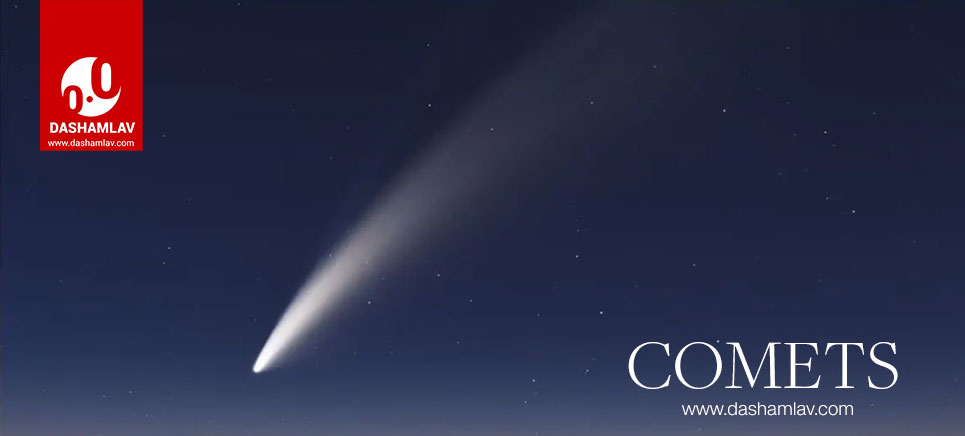Comets are small celestial bodies that, like asteroids, orbit around the Sun. However, unlike asteroids, comets are primarily made of frozen gases like ammonia, methane and water. Comets have a small rocky core, called the nucleus. Orbit of comets around the Sun is usually highly elliptical. When comets pass close to the Sun, the frozen gases warm up and evaporate. These escaping gases create a visible atmosphere around the comet, which sometimes extends in the form of a tail. A trailing brilliant streak of gases is the most distinguishing feature of a comet.
Origin of Comets
Comets are believed to be originating either from Kuiper Belt or the Oort Cloud. Kuiper Belt is a region beyond the orbit of Neptune containing asteroids. Oort Cloud is located even father away and is like a spherical cover of icy bodies around our solar system. When comets approach nearer to the Sun, they shed their mass in the form of escaping gases. Thus it can be safely assumed that comets have a fixed and much smaller lifespan than other bodies in the solar system. Lifespan of comets is estimated to be a few thousand years. We know that the solar system came into existence billions of years ago, therefore all the comets would have been finished by now — had there not been a place where from new comets originate.
Asteroids and icy bodies from Kuiper Belt and Oort Cloud are knocked off their original orbit due to collision with other bodies or by the gravitational force of bigger objects. These deflected asteroids/icy bodies become comets. Comets originating from Kuiper Belt have shorter orbits while comets from Oort Cloud have much larger orbits.
Famous Comets
Halley’s Comet
The most well-known comet is Halley’s Comet, which is a short-term comet visible from the Earth after every 75 or 76 years. This is the only comet visible to the naked eye that can be seen twice in a human lifetime. Halley’s Comet became visible from the Earth last time in 1986. The next time it will be seen from the Earth in 2061. It was named after the British astronomer Edmond Halley.
Comet NEOWISE
This recently discovered long-term comet was seen from the Earth in July 2020. Comet Neowise was discovered on 27 March 2020 using the Wide-field Infrared Survey Explorer (WISE) space telescope. It was a very bright comet and was visible even from cities with light pollution. Neowise is probably the most widely photographed comet.

Comet Hale-Bopp
Named after discoverers Alan Hale and Thomas Bopp, the Comet Hale–Bopp was discovered on 23 July 1995. It became visible to the naked eye in 1997. It was visible to the naked eye for a record 18 months. Thirty-nine members of the Heaven’s Gate cult committed mass suicide in March 1997 with the intention of teleporting to a spaceship which they believed was flying behind the Comet Hale-Bopp.
Great Comet of 1811
This comet was visible to the naked eye in 1811 for around 260 days — the longest period until it was overshadowed by Comet Hale-Bopp.
Facts about Comets
- Orbit of comets is highly elliptical; far more elliptical than any of the planets in the solar system.
- In such an orbit, the closest point to the Sun is called perihelion and farthest point is called aphelion.
- Comets are also known as dirty snowballs or cosmic snowballs because of their icy make-up.
- Comets are made of an amalgamation of rock, dust, water ice, and frozen carbon dioxide, carbon monoxide, methane, and ammonia.
- Comets have two tails — a tail of dust (which is visible to naked eyes) and a tail of plasma (which can be photographed but difficult to see with unaided eyes)
- It is believed that there could be over one billion comets in our solar system. However, only about 6,6०० comets are known to us.
- It is safe to travel through a comet’s tail. When Earth passes through a comet’s tail, we get to see meteor shower.
- Tail of a comet remain away from the Sun because of the solar wind.
- There are comets which takes millions of years to be visible from Earth. These long-term comets originate from Oort Cloud and have a highly elliptical orbit around the Sun.
Use the citation below to add this article to your bibliography
"Comets: Definition, What They are Made of and Other Facts." Dashamlav.com. Web. 27 July 2024. <https://dashamlav.com/comets-definition-what-they-are-made-of-and-other-facts/>
Dashamlav.com, "Comets: Definition, What They are Made of and Other Facts." Accessed 27 July 2024. https://dashamlav.com/comets-definition-what-they-are-made-of-and-other-facts/
"Comets: Definition, What They are Made of and Other Facts." (n.d.). Dashamlav.com. Retrieved 27 July 2024 from https://dashamlav.com/comets-definition-what-they-are-made-of-and-other-facts/
